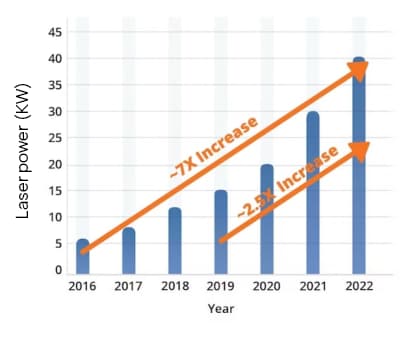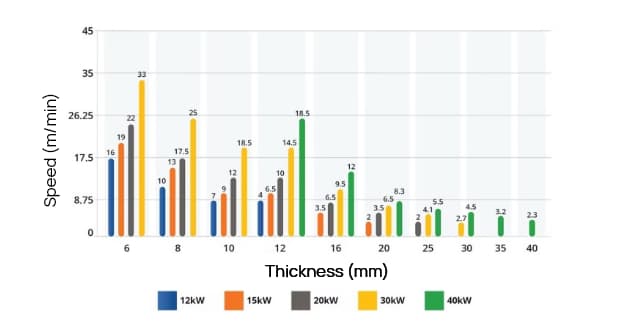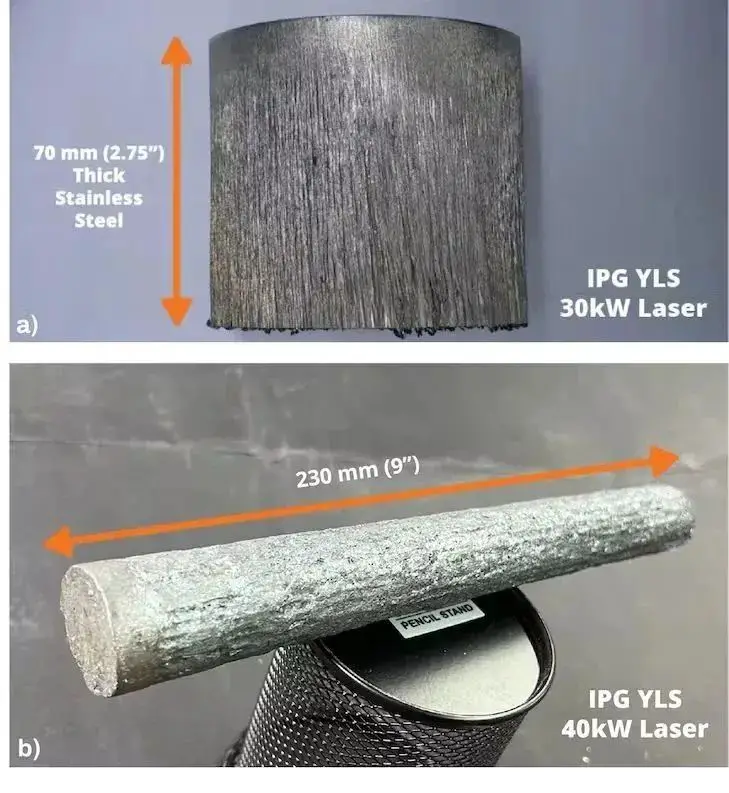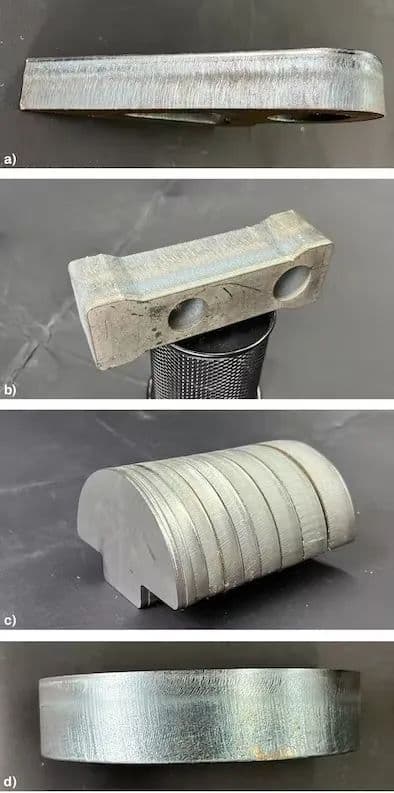P redo
Ultra-high-power fiber lasers are capable of fast, high-quality cutting of thick sheets, which includes the use of air as an auxiliary gas to cut stainless steel, and offer several advantages over other cutting methods.
In recent years, ultra-high power (UHP) fiber lasers, with power ranging from 10kW to 40kW, have been rapidly adopted in the cutting market, and the maximum laser power for cutting applications is expected to continue to increase .
In this article, we will show the effects of applying cutting in this power range and discuss the key factors driving the application of ultra-high power fiber lasers, including significant productivity advantages, improvements in cut quality, and the ability to cut materials thicker. such as 230 mm thick stainless steel and 40 kW.
For the purposes of this article, ultra-high power lasers are defined as those with power greater than 10kW, which enable new process methods that can expand laser cutting into new markets. One such method is the use of air as an auxiliary gas to cut stainless steel up to 50mm thick, resulting in cutting speeds up to 4 times faster than high power plasma cutting.
Application results demonstrate that ultra-high power lasers are transforming stainless steel cutting, using air cutting technology instead of nitrogen and oxygen cutting technology, resulting in high-quality, high-speed and cost-effective cutting.
6-year development trend: maximum laser power for cutting applications

Figure 1: Maximum fiber laser power growth used in cutting equipment since 2016
Laser cutting technology emerged more than 50 years ago and has experienced rapid development since then. In the 1970s, the first commercial laser cutting machine was released, which early adopters used for mass production.
In the 1980s, CO2 laser cutting equipment became widely used, and in the late 1990s and early 2000s, high-power fiber lasers were introduced. In the late 2000s, the development of kilowatt-class fiber optic laser cutting machines made laser cutting a mainstream manufacturing technology from a small-scale application.
Fiber laser cutting machines occupy a significant position in the metal plate laser cutting market due to their easy integration, reliability, low maintenance and operation costs, high cutting output, and power expansion feasibility.
In the late 2010s and early 2020s, the laser cutting market experienced growth in two directions. The first trend encompasses the low-power segment of the market, with a sharp increase in demand for 1-3 kW cutting machines as equipment capital costs decline.
The second trend is in the high-power end market, which also leads to increased demand for ultra-high-power lasers. This is driven by the high productivity and technical capabilities provided by ultra-high-power lasers with a high cost-performance ratio. The field of laser cutting has undergone an unprecedented “power transformation” unmatched by other sheet metal manufacturing processes of the same period.
In the processing and manufacturing exhibitions, we can see that the maximum laser power of the cutting machines on display has increased from 6 kW in 2015 to 40 kW in 2022, an increase of almost 7 times (see Fig. 1). In the last three years alone, the maximum power of laser equipment has increased from 15kW to 40kW, a sharp 2.5-fold increase!
Why is this the best time?
Before the emergence of the ultra-high power cutting trend, reliable high-power fiber lasers had been available for a few years. Already in 2013, industrial fiber lasers with a power of 100 kW were introduced.
However, it is only in recent years that the price per kilowatt of lasers has dropped rapidly, which has lowered the threshold for ultra-high power laser cutting. The development of cutting heads capable of withstanding high laser power in harsh cutting environments has also contributed to this trend.
Furthermore, the cutting database that can adapt to ultra-high-power cutting equipment is continuously improving, providing more accurate cutting capabilities.
Cutting test
This test employs IPG 40kW YLS-40000 and IPG 30kW YLS-30000-ECO2 high-efficiency electro-optical conversion fiber lasers, along with a 100 µm fiber core diameter and IPGCut-HP cutting head, to evaluate the cutting speed and quality of various metals.
To our knowledge, the laser power of 40 kW and the fiber core diameter of 100 µm represent the highest laser power available in an industrial laser cutting light source.
We selected a 100 µm diameter fiber core as it provides 10-25% faster cutting speed than a 150 µm fiber core.
Cutting carbon steel with air as an auxiliary gas
Cutting speed vs. Laser power

Fig. 2: Schematic diagram of cutting speed and power of free-air cutting of carbon steel slag
Faster cutting speed
Our experiments demonstrate that laser cutting speed increases as average power increases (up to 40 kW) for all metals tested, including stainless steel, carbon steel and aluminum.
Figure 2 shows the relationship between cutting speed and laser power for 6 to 40 mm carbon steel with air, between 12kW and 40kW. The growth rate increases with the thickness of the metal.
For example, when cutting 12mm thick carbon steel, the cutting speed of 40kW is 280% faster than that of 15kW (with 270% more power). Cutting 20mm thick carbon steel at 40kW produces a cutting speed that is 420% faster than 15kW. Cutting 30 mm carbon steel with a 33% increase in power, from 30 kW to 40 kW, results in a 66% increase in cutting speed.
Therefore, ultra-high power lasers with higher power levels can further increase the efficiency of cutting thick sheets. However, to significantly reduce the production cycle using the faster cutting speed provided by the ultra-high power laser, it is essential to cut parts, especially thin ones, at high acceleration.
In recent years, the maximum acceleration of laser cutting machines has increased from 1G to 3G to accommodate higher laser power. In the high-end market, the acceleration of ultra-high-power laser cutting machines can reach a maximum of 6G, and their mechanical design guarantees no noticeable deviation in the cutting path.
Reduce unit parts processing cost and achieve rapid return on investment
Compared to lower power options, ultra-high power laser cutting significantly reduces the cost of processing unit parts, leading to a faster return on investment and greater profitability.
In laser cutting, the processing cost arises mainly from gas consumption, which normally increases with the thickness of the part. However, ultra-high power laser cutting requires equal or smaller gas pressure and nozzle size than low power cutting. The cutting speed of the ultra-high power laser is faster, which reduces the cutting time of unit parts and greatly reduces gas consumption.
For example, a 30 kW laser can cut a typical 16 mm thick stainless steel part in half the production cycle of a 15 kW laser, cutting gas consumption in half.
Although the power consumption of lasers and chillers generally increases linearly with laser power, other cutter power consumption remains the same. Therefore, increasing the laser power reduces the total energy cost of each component. With the continuous development of IPG technology, the electro-optical conversion efficiency of high-power fiber lasers is more than 50%, leading to greater energy savings.
Ultra high power lasers can also save gas usage. High pressure air can be used to cut thick carbon steel quickly and without slag, avoiding the more expensive nitrogen or oxygen's slower cutting speed. Ultra-high power also allows for reduced air pressure required for slag-free cutting in nitrogen and air cutting.
For example, using a 20 kW or higher power laser to cut 20 mm thick carbon steel requires only 10-12 bar of air pressure, while a 15 kW laser requires more than 16 bar. This significant depressurization helps reduce gas consumption and simplifies the specification of gas generating equipment.
The production efficiency of high-power laser cutting equipment is twice that of low-power laser cutting equipment, while the price of the equipment is not double. This is because the cost per kilowatt decreases as laser power increases. The cost of higher power lasers is included in the total cost of the equipment, showing marginal growth compared to lower power laser equipment.
Therefore, ultra-high power laser cutting machine can achieve twice the production efficiency through higher laser power, while the equipment cost only increased by 30-40%. Due to the significant improvement in production efficiency, ultra-high-power equipment can replace various low-power equipment, reducing floor space, operators and facility preparation.
To ensure production efficiency, ultra-high power fiber laser cutting machine requires higher reliability of the laser source and cutting head. A stable power output and beam quality are required for the fiber optic laser source, which is affected by the quality of diodes, components and optical integration. The ultra-high power cutting head must withstand high laser power, high pressure gas, dust, process heat and high acceleration to achieve stable and reliable processing.
| Item | Oxygen | Nitrogen | High pressure air |
| Gas equipment cost | low | Low to high | high |
| Gas operating cost | low | high | very low |
| Flow | low | very high | very high |
| Slag | None/Low | average | none/low |
| Long-term repeatability of production quality | Medium/High | very high | very high |
| Sensitivity to the environment of the material surface | Average | low | low |
| Sensitivity to material composition | high | low | low |
| Heat affected zone | Average | small | small |
| Ability to cut complex or high aspect ratio workpieces | Average | high | high |
| Degree of oxidation of the cutting surface | serious | anything | moderate |
| Cutting surface roughness (Rz) | low | secondary | medium/high |
| Aesthetic grade of the cutting surface | good | secondary | poor |
| Notch width | big | small | small |
| Laser power required for slag-free cutting | low | N/A | average |
- The scale of production determines the requirements.
- The equipment is necessary to pressurize the air and filter moisture and oil.
- Oxygen cutting uses low pressure (generally between 5-20 psi) and a small orifice nozzle.
- Nitrogen cutting requires high pressure and a large nozzle.
- Air cutting as a feature is free.
- The level of oxidation and the thickness of the oxide layer must be taken into account.
New process scheme for cutting stainless steel
Carbon steel can be cut with oxygen, nitrogen or air as an auxiliary gas.
Although oxygen cutting is effective in cutting thick carbon steel using lower laser power due to additional oxidation energy, the cutting speed is not directly proportional to the laser power. This can lead to reduced production efficiency.
On the other hand, the cutting speed of carbon steel air cutting is directly proportional to the power (see Fig. 2).
For example, for 16mm carbon steel, the oxygen cutting speed remains around 2m/min when the power is between 10kW-30kW, while the air cutting speed is more than 9m/min at 30kW, making it 4.5 times faster than the oxygen cutoff speed.
For thicknesses that require oxygen cutting only at lower power and speed, ultra-high power lasers and air processing are now available, which is several times faster and produces a better quality finish.
However, for low power lasers, air cutting can lead to slag suspension, which can be difficult to remove and produce a poor quality surface.
The development of this innovative and efficient ultra-high-power processing scheme is gaining popularity among industries such as construction equipment manufacturing and heavy industry, which require a significant amount of thick plate processing.
We will discuss the development history and cutting advantages of ultra-high-power fiber lasers. In the next edition, we will continue to present more competitive advantages of ultra-high-power laser cutting through real case studies.

Fig 4. Cutting very thick stainless steel in pulsed mode using an ultra-high power laser cutter
(a) 30 kW power, nitrogen cutting, 70 mm thick stainless steel;
(b) Power 40 kW, air cutting of 230 mm thick carbon steel.
Improve the thickness, yield and cutting quality of sheet metal
Test results indicate that as the power of the ultra-high-power laser increases, the cutting thickness capacity also increases. For example, in Figure 4, cutting 70 mm thick stainless steel using nitrogen at 30 kW and 230 mm thick carbon steel using air at 40 kW is demonstrated in pulse cutting mode.

Fig. 5 Cutting at maximum speed in continuous mode
(a) The IPG 40kW YLS laser is used to cut 28 mm thick carbon steel through air at a speed of 4.5 m/min (177 ipm).
(b) The IPG 40kW YLS laser is used to cut 40 mm thick stainless steel at a speed of 2.3 m/min (90 ipm).
(c) IPG 30kW YLS-ECO laser, when combined with nitrogen, is used to cut stainless steel profiles with a thickness of 3 to 25 mm.
(d) Cut 30 mm thick carbon steel with a power of 15 kW and oxygen.
In continuous wave (CW) full speed cutting mode, 20 kW slag free air is used to cut 20 mm thick carbon steel, 40 kW slag free air is used to cut 30 mm thick carbon steel thick and 40 kW of free-air slag is used to cut 40 mm thick carbon steel (see Figures 2 and 5a in the previous section).
When cutting stainless steel, it is easier to achieve a slag-free effect, so the cutting limit thickness is thicker than that of carbon steel (see Figure 5b and Figure 5c).
For continuous cutting with nitrogen and air, slag-free cutting and a good cutting surface can only be achieved within a certain thickness and with any power. If it exceeds a certain thickness, pulse cutting (which is slower than continuous cutting) must be used to obtain acceptable quality; otherwise, the laser power must be increased.
Generally, a cutting speed of less than 2 m/min means that the laser power in continuous mode is insufficient to achieve the best cutting quality.
For oxygen cutting of carbon steel, assuming that the cutting surface is smooth, increasing the power will increase the cutting limit thickness. For example, the limit cutting thickness of 4 kW is about 6-8 mm, while the limit cutting thickness of 15 kW is 30 mm.
Figure 5d shows a 30 mm thick carbon steel sample cut at 15 kW.
Faster and cleaner drilling
Utilizing the peak power of an ultra-high power laser in pulse mode can quickly drill through thick metals with minimal spatter.
Drilling time for 16mm stainless steel is significantly reduced from over 1 second at 6 kW to 0.5 seconds at 10 kW and 0.1 seconds at 20 kW.
In practical applications, a drilling time of less than or equal to 0.1 seconds is generally considered “instantaneous”.
Higher peak power increases the molten pool depth-to-width ratio, allowing faster bridging of thicker materials with less transverse melting.
Reducing transverse melting also minimizes spatter on the top surface.
Competitiveness of ultra high power laser cutting
Over the past six years, several technological developments have contributed to improving laser cutting performance. These developments include:
- Selection of a variety of collimating or multi-core optical fibers to determine the focal spot size required;
- Implementation of high-speed rotating beams that can improve the efficiency and quality of processing certain metals;
- Using high peak power continuous lasers for faster and cleaner complex drilling/cutting; It is
- Using ultra-high power lasers.
Although the needs of different industries are different, all enabling technologies are used in specific areas. However, ultra-high-power laser cutting is a leading technology trend that promotes the improvement of laser cutting performance.
This can be verified by the widespread use of ultra-high-power lasers in global laser cutting machines. With more exposure to ultra-high power lasers, application engineers have discovered numerous output and quality benefits exceeding those of lower laser power, enabling technology with less complexity.
Ultra-high power lasers have significant advantages in thickness cutting, quality and economy in cutting thick sheets, especially at 15 kW and higher power levels. They are more competitive than high current plasma cutting machines.
Comparison tests have shown that for stainless steel up to 50mm thick, the 20kW fiber laser is 1.5-2.5 times faster than the high current intensity (300A) plasma cutter.
Related Reading: Laser Cutting vs. Laser Cutting plasma cutting: the differences explained
For carbon steel, cutting up to 15mm thick is twice as fast, as demonstrated by empirical evidence.
According to calculations, the total cost of cutting per meter of 15 mm thick carbon steel using a 20 kW laser is about two times lower than when using plasma.
Compared to high-power plasma, using a 40 kW laser to cut sections of stainless steel with a thickness of between 12 and 50 mm is three to four times faster, while cutting sections of low-carbon steel with a thickness of from 12 to 30 mm is three to five times faster. , resulting in significantly greater productivity differences.
Ultra high power laser
Compared to low-power lasers and other cutting processes such as plasma cutting, the main driving force behind ultra-high-power lasers is increased productivity and reduced cutting costs for each component.
The use of ultra-high power lasers results in speed gains that provide manufacturers with economies of scale. For example, increasing power from 30 kW to 40 kW leads to a 33% increase in speed and a 66% increase in cutting speed.
Ultra-high power lasers can achieve fast and high-quality air cutting of carbon steel, which is more advantageous than slow oxygen cutting and expensive nitrogen cutting. In our tests, using 40 kW air to cut carbon steel up to 50 mm thick was three to four times faster than using high-power plasma.
The ultra-high power laser makes laser cutting more competitive in many other aspects. It can increase thickness and cut quality (materials up to 230mm thick can be cut), reduce or eliminate subsequent processing costs (which can minimize slag suspension), reduce floor space and installation costs , reduce labor requirements and improve drilling quality and production.
As ultra-high-power laser power and energy efficiency continue to improve, these advantages will become more apparent, increasing their ability to quickly and cost-effectively adapt to cutting applications across a variety of industries.

























































